 Back to selection
Back to selection
Shutter Angles
Conversations with DPs, directors and below-the-line crew by Matt Mulcahey
Cinematographer Michael Fimognari on Shooting the Netflix Series Midnight Mass and Stripping Away Departmental Hierarchy with Red, Green and Blue Camera Teams
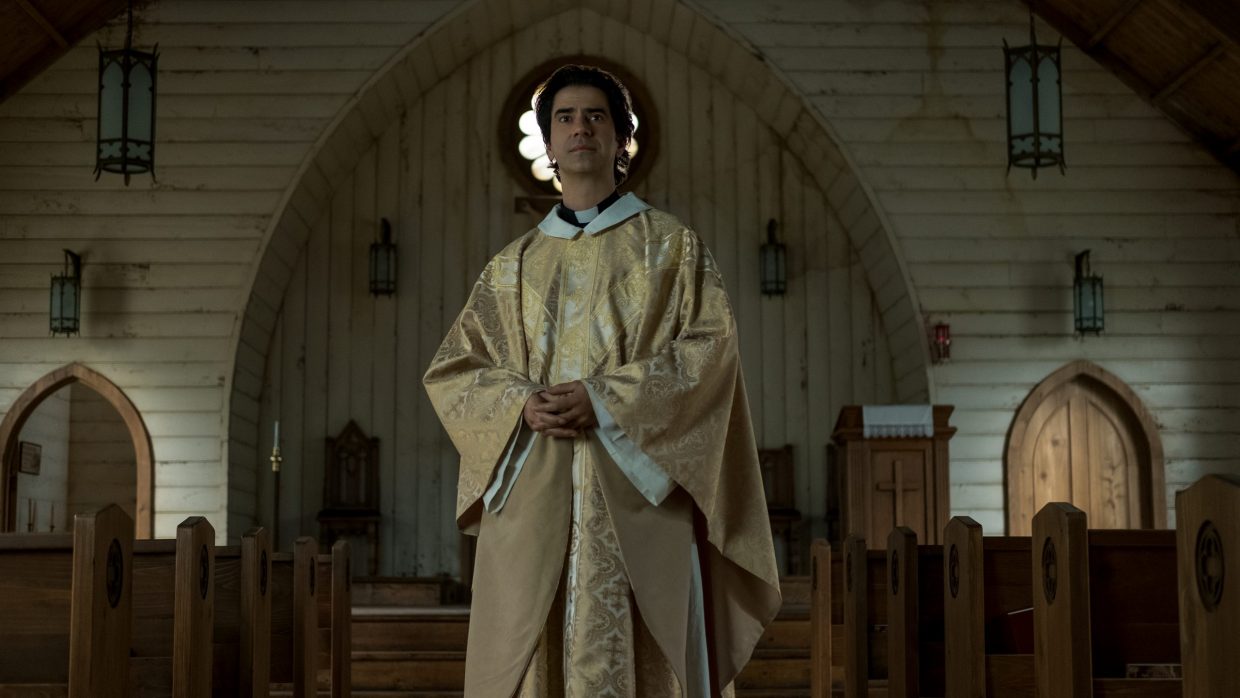 Midnight Mass (L to R) Hamish Linklater as Father Paul (Photo: Eike Schroter/Netflix © 2021)
Midnight Mass (L to R) Hamish Linklater as Father Paul (Photo: Eike Schroter/Netflix © 2021) In Midnight Mass, the arrival of a new priest upends the small, isolated fishing community of Crockett Island. It’s an original idea from writer/director Mike Flanagan, who made his name in the horror genre adapting Shirley Jackson, Henry James and multiple Stephen King opuses. Flanagan has been excavating the bones of Midnight Mass for years and at various stages it morphed from novel to film to series. The characters’ inner demons and struggles with addiction and faith mirror his own, with details taken from Flanagan’s youth as an altar boy on New York’s Governors Island.
With the personal nature of the project, it’s no surprise that Flanagan turned to Michael Fimognari behind the camera. Since first teaming on 2013’s Oculus, they have paired on Before I Wake, Ouija: Origin of Evil, Gerald’s Game, The Haunting of Hill House, and Doctor Sleep.
With Midnight Mass now streaming on Netflix, Fimognari talked to Filmmaker about building a town from scratch, creating honest light on a bluescreen stage, and his experiment in stripping away the regimented hierarchy of the camera department in favor of a more egalitarian approach.
Filmmaker: How did you start working with Mike Flanagan?
Fimognari: I actually met (Midnight Mass producer) Trevor Macy on a project that I didn’t end up doing, and he brought me back in the room to meet Mike when they were putting up Oculus. I immediately fell in love with the writing, and that was my introduction to Mike’s work in general. Then I watched (Flanagan’s 2011 film) Absentia and loved it. I saw that he was committed to telling a story in every way possible. He has a command of the visuals, the editing, and the way that sound plays a role. We hit it off, and I’m really grateful that relationship started when it did because we’ve had the good fortune to work together almost every year since. It’s been a real adventure and a great collaboration.
Filmmaker: Midnight Mass is a project that’s been rattling around Mike Flanagan’s head for a long time. When did he first mention it to you?
Fimognari: I think I first became aware of it when [a faux Midnight Mass novel] popped up as a prop on the set of Gerald’s Game (2017). There are so many meaningful elements to Mike’s story world, and sometimes you catch little conversations about the hidden meaning behind something. Sometimes it’s a reference to a larger work that Mike is inspired by, like a Stephen King reference, and sometimes it’s from his own world.
Filmmaker: Tell me about this town that was built in Vancouver to stand in for the fictional Crockett Island.
Fimognari: All the structures that you see are built. Production designer Steve Arnold and the entire art department did a fantastic job building that world. We circled the concept of the island in prep for a while. We talked about the division between how much should be done in controlled stage environments versus putting ourselves out there in the elements, where, especially in Vancouver, you can get hit hard sometimes for weeks with rain or snow. The first element for us was to find the right landscape. It’s an island so it can’t have those Pacific Northwest mountain views or steep hills. That ruled out quite a few environments for us. We ended up searching and searching and searching and, ultimately, we split it up into two parts. There was the water view, which we found in a park, and fortunately we were able to get permission to close a portion and build structures. Then there was a big plot of land that the larger portion of the town was built on — the church and the town square and everything else. The trick there was once again finding the right spot where you could put a camera anywhere and move it 360 degrees and have the view always be faithful to the island. We spent a lot of time there just walking those spaces and figuring out things like where the paths should go in the town. We walked out our long walk-and-talk scenes where we wanted to film unbroken shots, and we talked about things like what to make the roads out of so we didn’t hear a lot of crunching and moving while the actors were talking. Mike is a very specific leader. He can tell you what matters and what doesn’t and where to put your time. We have very specific shot lists —that’s really the first step for us. It’s been that way since Oculus. Then we put them down into overhead plans so that everybody can see them because Mike plans out his blocking. He really understands where he wants the characters and how he wants them to move.
Filmmaker: Were many of those builds dual purpose or were most of the interiors done on stage?
Fimognari: Almost all the interiors were on stage. There were a handful that required a transition shot from an exterior to an interior, but not many. The general store was one that was shot on location. There were just too many windows, and we followed people in and out of the doors, but most of the interiors were stage work.
Filmmaker: You’re known for two very different types of movies — the Flanagan horror films and then also the To All the Boys I’ve Loved Before Netflix romcoms. I really love the work you did on the latter. You went with some very flavorful anamorphic lenses that really stand out from what you normally see in that subgenre. What’s your process for initially finding the look of a project?
Fimognari: I just love that early process where you let the script inform you — you put on some music and try not to overthink it too much. Let the words on the page do the work. When I read scripts, I try to give it a good five full reads before I really start to think about what the thing looks like. I feel like after you’ve read [a script] over and over again you start to pick up meaning, intentional or not, even within some of the descriptive words that start to create a feeling about a space or a character, and you start to have opinions about what this really looks like. A lot of it is just your gut. And then we get to the point where we overanalyze and really get in there.
Filmmaker: You’ve shot Alexa 65 for the last few projects with Mike Flanagan. Did you continue that with Midnight Mass?
Fimognari: It was Alexa, but we decided to go with the LF. It was the first time that we departed from the 65 in a while. We used the 65 on Gerald’s Game, Hill House and Doctor Sleep. We wanted a lighter camera for Midnight Mass, so we were willing to trade that mobility instead of having some of the extra resolution. The LF also allowed us to shoot with anamorphics, which wouldn’t have been an option on the 65. So it was the right combination of elements. We rated the LF’s at 1600 ISO and shot on Atlas Orion anamorphics. We wanted lenses that had a slightly ambiguous quality at the edges so that they weren’t perfect, and we wanted (lenses that were fast enough to allow) the candlelight to do some real work. We found the Atlas Orions to do both.
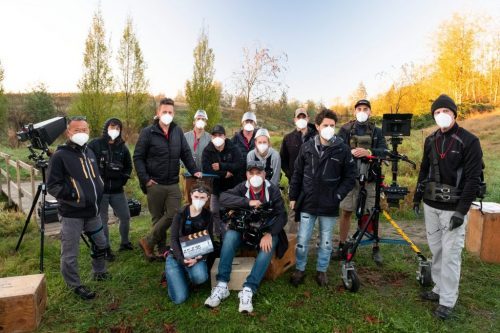
Filmmaker: In the credits, the camera teams are labeled as Green, Red and Blue rather than A, B and C camera. What’s the story behind that?
Fimognari: This was the first time that we’ve done that. It was something that I pitched to our team because there’s a thing that sometimes happens where you get caught up in the hierarchy of what the A Camera means and what the B Camera means. Sometimes people feel like some shots are more important than others just based on which camera is doing them, or some teams feel entitled to have the more challenging shot or the shot that is perceived to be more important based on [those letter] designations. I felt strongly that we needed to strip that away. On our shot list every shot matters. There’s no shot that isn’t on the page for a reason. We had some people who we considered to be part of the team who essentially opted out of the project because they cared very much about the designation on their credit. They said, “I’m only going to do it if I’m the A Operator or the A 1st.” And I explained, “Hey, I get it. You will be treated that way, but we’re not going to name it that way.” And some people said, “No thanks,” which is fine. That sort of served its purpose [in building the team] as well because we want everybody to feel like their shot is important, because it is, and we want everybody to feel equal on the team, because they are.
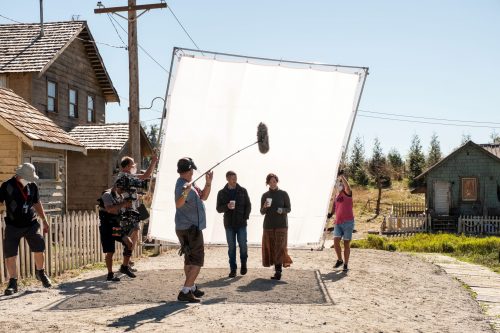
Filmmaker: So much of what makes this island community feel tangible in Midnight Mass are the linking shots that might normally be given that B or C camera designation — all these little slivers of atmosphere you capture. For example, there’s a shot of this little bobblehead owl ornament along a white-picket fence that stood out to me, and it’s the accumulated effect of those types of shots that give you a real sense of this place.
Fimognari: Yeah, the world was full. Art department really did create a town. On its exterior face, you could go anywhere in that town and find a shot because it was fully dressed. So the opportunities were endless. Any time that I saw something as I was walking by, I’d make a note or take a picture and say, “Hey, we’ve got to go back and get this.” It was a nice little break from the scene work, to go find relevant beauty moments.
When we had some of those nice long walk-and-talks designed to be one shot, we would then have a camera team that was available and a whole other section of town that we weren’t seeing. Sometimes we knew that we needed specific transitional elements that were on the shot list related to the geography of the town that we had to make sure we got, but other times we would give [the camera team that wasn’t playing in a long oner] the freedom to walk around and find those little details like you pointed out. We were there shooting for so long that it worked out that we got the town in all different weather conditions and different lighting conditions.
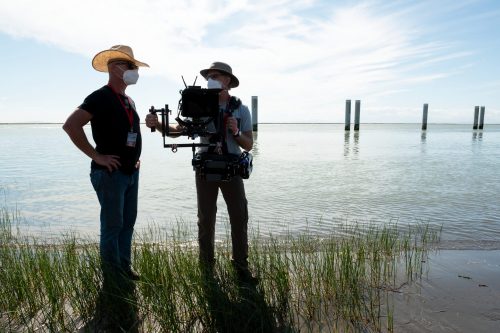
Filmmaker: Since you mentioned long oners, let’s talk about the seven-minute shot on the beach that opens Episode 2. I didn’t see any moments that I thought looked stitched. Is that an actual oner?
Fimognari: Yeah, that’s definitely one shot. It wasn’t as defined as a lot of the one shots we did in Hill House, where the space is really tricky and inches matter. On the beach, there’s a little wiggle room. As we did on Hill House, we mapped it out first on our own with some stand-ins, walking it with simple tools like cell phones. Then once the set was built we went back again and rehearsed it with the cast to make sure it all felt right. Then it was actually — I don’t want to say easy because doing something like that is not easy — but by contrast to Hill House we felt like we knew what we were getting into. It was early in our production, so it was right when everyone was getting accustomed to Covid protocols. That was probably the most challenging part of it, honestly, just learning to communicate with each other and trying to do something that involved that many people while wrangling these new rules.
Filmmaker: That shot takes place in multiple different points on the beach and the camera is constantly circling characters. Is that just natural light because there’s definitely nowhere to hide any frames?
Fimognari: It’s all natural. There wasn’t really an opportunity to try to get a bounce in there. I’m also a believer that, especially when you’re walking and moving, if [the crewmember directing the bounce] catches the angle of the sun wrong, you can get this little flash or this little ping of light on somebody that feels unnatural. It just wasn’t worth the risk. So I’d rather let the shadow side go a little deep and let the shimmer on the water really shine and just let it be what it is.

Filmmaker: At the end of Episode 5, there’s a scene set on a rowboat at sunrise that was shot against bluescreen. How did you create that effect on stage of going from night to dawn to daybreak?
Fimognari: The sunrise required a very, very specific transition and it needed to be repeatable. For our exteriors we made sure that we were there at the right time of day to shoot them. I take that very seriously when I’m organizing the order of the days with the assistant directors. Like, “This is where we need to be at this time for this to be right.” But in the case of the boat, that’s all bluescreen, so we’re trying to create that same level of honesty on stage. We built the timing of those transitions in the softbox overhead that moves us out of night and into that early morning blue and then into the pre-sunrise. Then we had a 20K on a crane arm that came up from behind a blind that represented the sun coming up. Your board operator and your gaffer have to be in sync and listening to the actors on their headphones to make sure that the sun breaks on the right line. We rehearsed that several times [before the actors came in] because once you put the cast into it, it’s such an emotional scene you really don’t want to have them doing it over and over for timing or quality of light. So that was a thing that we spent a lot of time designing and refining.
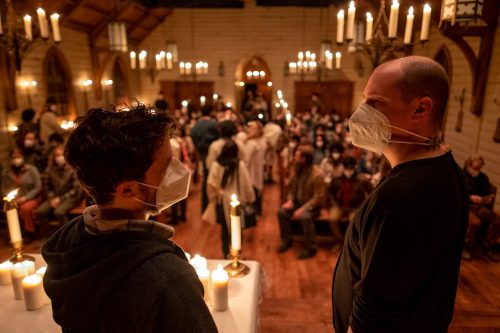
Filmmaker: To finish up, walk me through lighting the church in Episode 6, where the scene is entirely motivated by candlelight.
Fimognari: One of the first tests we did to make sure it was going to work out with the Atlas Orion anamorphics was to just light with candles — get double wick candles and hold them close to someone’s face to see what kind of output we were getting and what kind of lens flares we were getting and to see how soft it was going to be to shoot them almost wide open. And I felt like they held up terrifically. Also, at that point the church interior had been built so it was on stage. So we could do the test in the church to see how much we were getting off those church walls and if we needed to adjust the paint color or tweak the reflecting value. Then when we shot those scenes we had I think six 12’ x 12’ boxes overhead that were all on motors so we could angle and tweak and control them. That gave us a sort of bed of light to give us the exposure we needed, but then we really did rely on those candles to do a lot of work because without them you wouldn’t get that natural flicker.
Matt Mulcahey works as a DIT in the Midwest. He also writes about film on his blog Deep Fried Movies.
